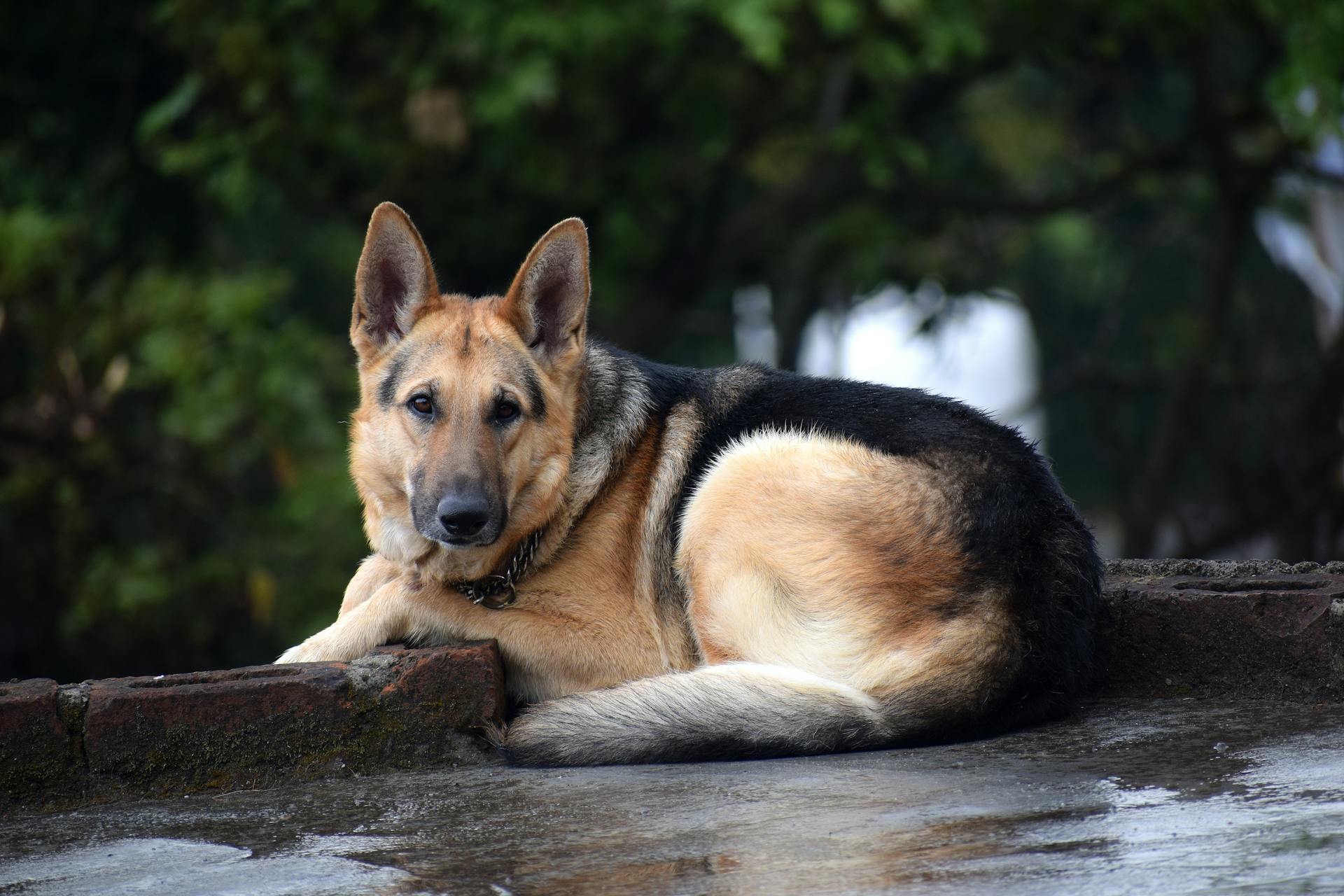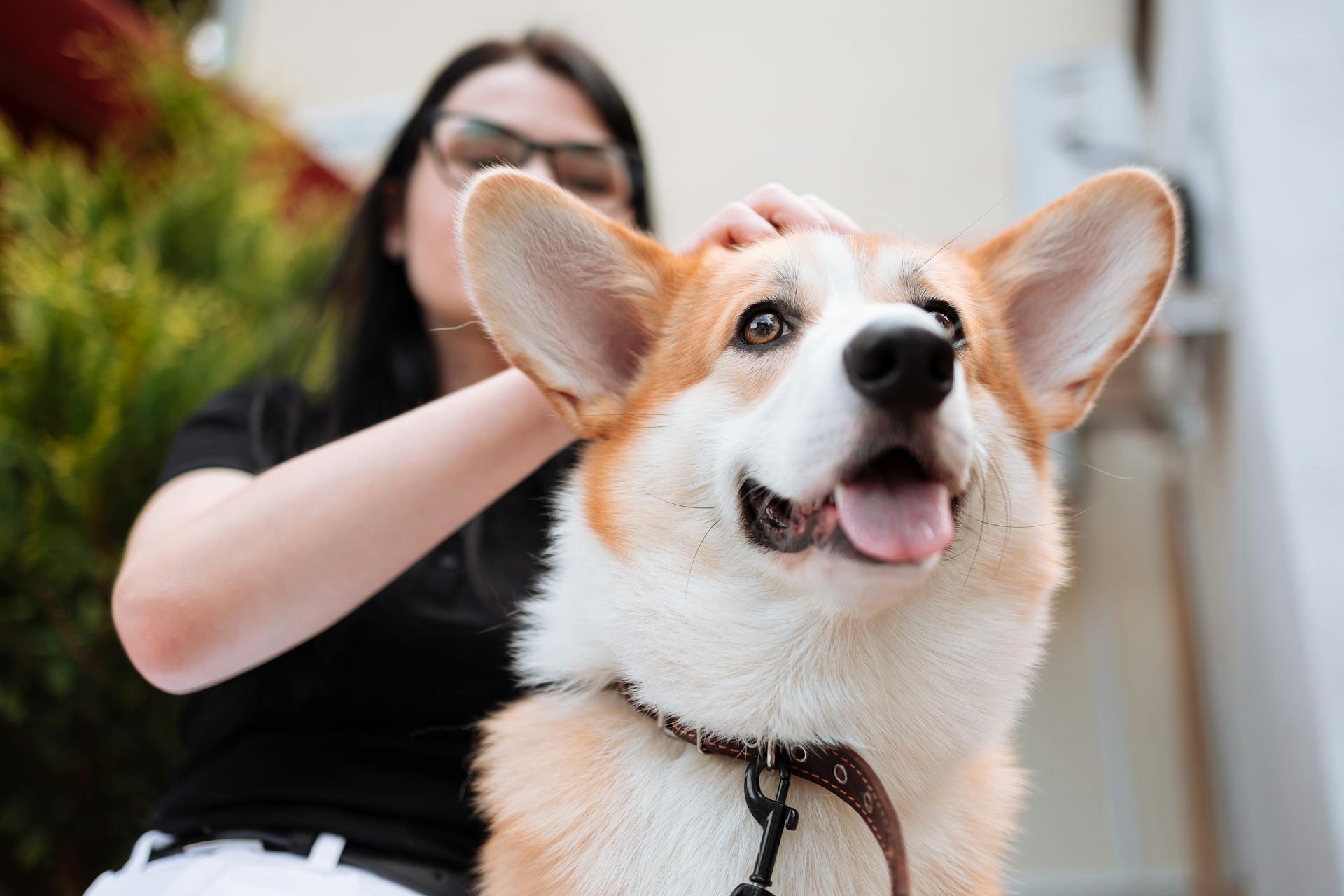
German Shepherds are known for their agility and athleticism, but unfortunately, many owners face problems with their back legs. Hip dysplasia is a common issue, where the hip joint doesn't form properly, leading to arthritis and mobility problems.
This can be a painful and debilitating condition for your dog, causing them to limp or avoid physical activity altogether. The American Kennel Club reports that hip dysplasia affects up to 20% of German Shepherds.
A healthy diet and regular exercise can help manage hip dysplasia, but in severe cases, surgery may be necessary to alleviate pain and restore mobility.
Understanding German Shepherd Leg Issues
German Shepherds are prone to back leg problems due to their genetics and physical traits. Their sloping back and powerful hindquarters can put stress on the hips and legs, leading to conditions like hip dysplasia and arthritis.
Hip dysplasia is a common issue in German Shepherds, affecting 19.8% of the breed. It's caused by a genetic predisposition and can lead to pain, discomfort, and reduced mobility. Dogs with hip dysplasia may exhibit a "bunny hop" gait, limping, or lameness in their hind legs.
Degenerative myelopathy is another neurological disease that affects German Shepherds, primarily affecting their back legs. It starts with weakness and a lack of coordination, leading to hind leg paralysis. While there's no cure, supportive care can help manage symptoms and improve comfort.
Here are some key statistics about the lifespan of a German Shepherd with degenerative myelopathy:
By understanding these factors, German Shepherd owners can take proactive measures to ensure their pets' well-being and make informed decisions regarding their care.
Hip Dysplasia
Hip dysplasia is a genetic condition that affects German Shepherds, causing the hip joint to develop improperly, leading to pain, lameness, and arthritis.
This condition is prevalent in German Shepherds due to genetic factors and breed characteristics, with 19.8% of the breed suffering from hip dysplasia, according to the Orthopedic Foundation for Animals.
Irresponsible breeding practices prioritizing certain physical traits over health have exacerbated the issue.
German Shepherds with hip dysplasia may exhibit a "bunny hop" gait, limping, lameness in the hind legs, and decreased range of motion.
Recommended read: Medium Mixed Breed Dogs
Untreated hip dysplasia can lead to arthritis in the hip joints, worsening the condition and further limiting the dog's mobility.
Responsible breeding practices are essential to reduce the prevalence of hip dysplasia in German Shepherds and improve the overall health of the breed.
Early detection through X-rays and various treatment options, including medication, physical therapy, weight management, and surgery, can help manage the condition effectively.
German Shepherds with hip dysplasia can be monitored and treated to reduce chronic pain, and with proper care, they can still lead happy and healthy lives.
Spinal Cord Conditions
Degenerative Myelopathy is a neurological disease that affects the spinal cord, causing weakness and paralysis in the back legs. It's a progressive condition that worsens over time, with no cure, but supportive care can help manage symptoms and improve comfort.
This disease is most prevalent in German Shepherds, and genetic predisposition is a significant factor. Early detection through genetic testing and vigilant monitoring can help owners take proactive measures to ensure their pets' well-being.
Degenerative Myelopathy typically affects dogs between the ages of 5-14, and its impact extends to their overall quality of life. They may lose the ability to perform basic tasks and become incontinent.
The lifespan of a German Shepherd with degenerative myelopathy can vary, but it's generally around 6 months to 3 years from the onset of symptoms. Early detection and a tailored treatment plan may slow the progression and extend the dog's life.
Here are some key factors that can affect the lifespan of a German Shepherd with Degenerative Myelopathy:
- Early Detection: Identifying DM in its early stages can be critical.
- Supportive Care: Providing comprehensive supportive care is essential.
- Progression Rate: The rate at which DM progresses can vary from dog to dog.
- Age at Onset: Dogs that develop DM later in life may have a longer lifespan.
- Secondary Complications: Secondary health issues or infections can arise due to DM.
Arthritis is another common condition that affects German Shepherds, particularly in their later years. It causes stiffness, pain, and reduced mobility, and treatment options include medications, weight management, and physical therapy.
Panosteitis
This condition primarily affects the long bones of a dog's legs, including the back legs. It can cause lameness, limping, and discomfort, which can come and go in different limbs.
The pain from panosteitis can be significant, but it's typically self-limiting and resolves as the dog matures. This means that most dogs will outgrow the condition.
German Shepherd owners should consult with a veterinarian to ensure proper care and rule out other potential causes of lameness.
Common Leg Problems
German Shepherds are prone to a range of leg problems that can affect their quality of life. Hip dysplasia is the most common cause of limping on the back legs in German Shepherds, a genetic condition that involves improper hip joint development, leading to pain and discomfort.
Hip dysplasia is a genetic condition that can be detected through X-rays and regular check-ups. Early detection is key to managing the condition effectively.
Degenerative myelopathy is a progressive spinal cord disease that affects the hind legs, causing weakness and loss of coordination. Unfortunately, there's no cure, but physical therapy, mobility aids, and supportive care can enhance your dog's quality of life.
Arthritis is also common in German Shepherds, particularly in their later years, often affecting the hip and knee joints. Symptoms include stiffness, pain, and reduced mobility.
Cruciate ligament tears can occur in German Shepherds due to their active nature and physical demands. These tears can significantly impact their life, particularly their back legs, and may require surgery in severe cases.
Osteochondrosis dissecans (OCD) is a condition that can affect the joints of the back legs in German Shepherds, causing pain, lameness, and reduced mobility. Early intervention is crucial to prevent long-term joint damage.
Luxating patella, a condition where the kneecap dislocates from its normal position, can also affect German Shepherds. Mild cases may be managed with weight control and physical therapy, but severe cases often require surgical correction.
Muscle strains and sprains can occur in German Shepherds due to their active lifestyle and breed characteristics, causing pain, limping, and reduced mobility.
Here's a list of common leg problems that can affect German Shepherds:
- Hip Dysplasia
- Degenerative Myelopathy
- Arthritis
- Cruciate Ligament Tears
- Osteochondrosis Dissecans (OCD)
- Luxating Patella
- Muscle Strains and Sprains
Early detection and proper management can significantly affect a German Shepherd's quality of life. Regular veterinary check-ups, a balanced diet, maintaining a healthy weight, and appropriate exercise can all contribute to preventing and managing leg problems.
Causes and Prevention
German Shepherds are prone to back leg problems due to their genetics and physical traits, which can lead to conditions like hip dysplasia and arthritis. Regular vet visits and preventive care are essential.
The sloping back of German Shepherds stresses their hip joints, making them susceptible to hip dysplasia. This breed-specific trait has inadvertently made them more prone to back leg issues.
Genetic testing is available to highlight dogs at risk of degenerative myelopathy, a genetic mutation that can cause back leg problems in certain breeds, including German Shepherds. This mutation almost certainly passes on to puppies as a recessive trait.
Here are some breeds that are commonly affected by degenerative myelopathy:
- German Shepherds
- Boxers
- Pembroke Welsh Corgis
- Cardigan Welsh Corgis
- Collies
- Retrievers
- Rhodesian Ridgebacks
- Siberian Huskies
- Weimaraners
- Wirehaired Fox Terriers
Prevention is key, and responsible breeding practices can reduce the risk of genetic issues in future generations.
Why Do Dogs Have Low Bodies?
Dogs have low bodies due to their breed's genetic characteristics, which can increase their agility and speed. This is evident in breeds like German Shepherds, whose sloping hindquarters are a result of selective breeding.
The sloping hindquarters, also known as back angulation, serves several purposes. It allows for powerful hind leg movement, aiding in agility and quick directional changes. This makes them excel in activities like herding and agility competitions.
German Shepherds are known for their ability to sprint and cover ground rapidly, making them effective working and service dogs. Their design contributes to their speed, which is a result of the sloping back.
However, this design can also increase the risk of certain back leg problems. Hip dysplasia, a common issue in German Shepherds, occurs when the hip joint doesn't develop properly, leading to pain and lameness.
Degenerative myelopathy, a spinal cord disease that affects the hind legs, is also a concern for this breed. The genetic predisposition can make them more susceptible to this condition. Back leg strain is another potential issue, which may result in conditions like arthritis over time.
To mitigate these risks, it's essential to maintain a healthy weight, exercise regularly, and consult with a veterinarian for preventive care and early detection of any potential back leg issues. This will help ensure the well-being of your dog.
Causes in Dogs
German Shepherds are prone to back leg problems due to their genetics and physical traits. Their sloping back and powerful hindquarters can put stress on the hips and legs, leading to conditions like hip dysplasia and arthritis.
Hip dysplasia is a genetic condition that involves improper hip joint development, leading to pain and discomfort. It's the most common cause of limping on the back legs in German Shepherds.
Arthritis is another common issue that affects German Shepherds, often due to their active lifestyles and genetic predisposition. It primarily affects a dog's back legs, causing stiffness, pain, and reduced mobility.
Regular exercise and maintaining a healthy weight are essential to minimize the impact of these conditions. By achieving and maintaining an ideal weight, you can reduce the stress on your dog's legs, allowing for better joint function and pain relief.
Here are some common causes of back leg problems in German Shepherds:
- Hip dysplasia
- Arthritis
- Injuries (such as torn ligaments or fractures)
- Degenerative myelopathy (a progressive spinal cord disease)
- Spondylosis (the formation of bony spurs along the spine)
These conditions can cause mobility challenges, pain, and discomfort, emphasizing the need for early detection and proper veterinary care.
Frequently Asked Questions
What to do when your dog's back legs keep giving out?
If your dog's back legs keep giving out, seek urgent veterinary care as it could be a sign of a serious injury such as a cranial cruciate tear or broken bone. Prompt attention is crucial to prevent further pain and potential long-term damage
How long can dogs live with weak back legs?
Dogs with degenerative myelopathy typically live 1-2 years after diagnosis, during which time their condition worsens and they may lose control of their legs, bladder, and bowels
What age do German Shepherds start having hip problems?
German Shepherds can start showing signs of hip problems as early as 4 months old. Early detection is crucial to manage the condition effectively.
Sources
- https://gsdcolony.com/blogs/news/german-shepherd-back-legs-problem
- https://www.pdsa.org.uk/pet-help-and-advice/pet-health-hub/conditions/degenerative-myelopathy-dm-in-dogs
- https://dogtime.com/dog-health/58629-degenerative-myelopathy-dogs-symptoms-causes-treatments
- https://orthodog.com/article/german-shepherd-hip-dysplasia/
- https://www.dogshealth.com/arthritis-in-german-shepherds/
Featured Images: pexels.com


